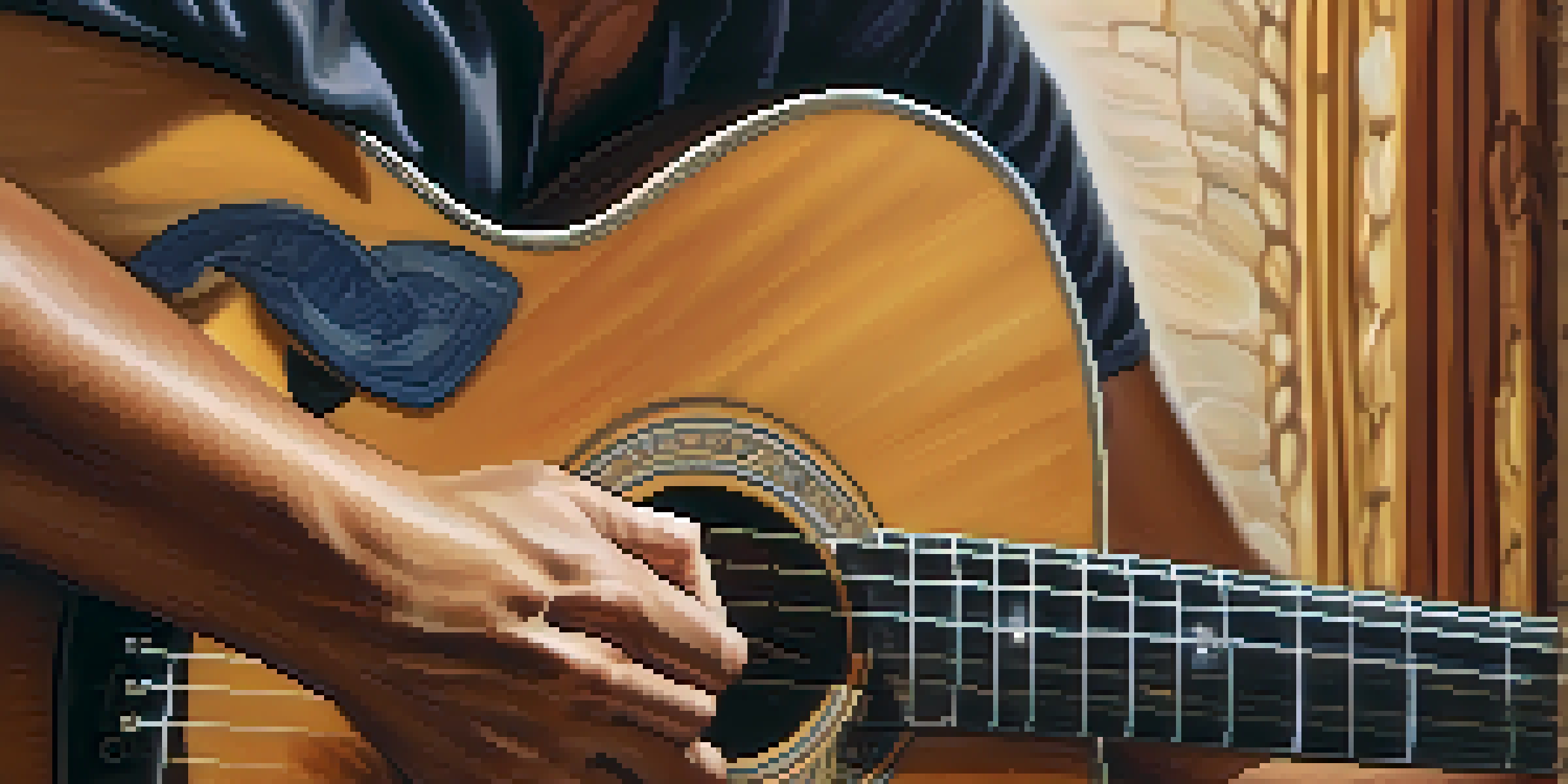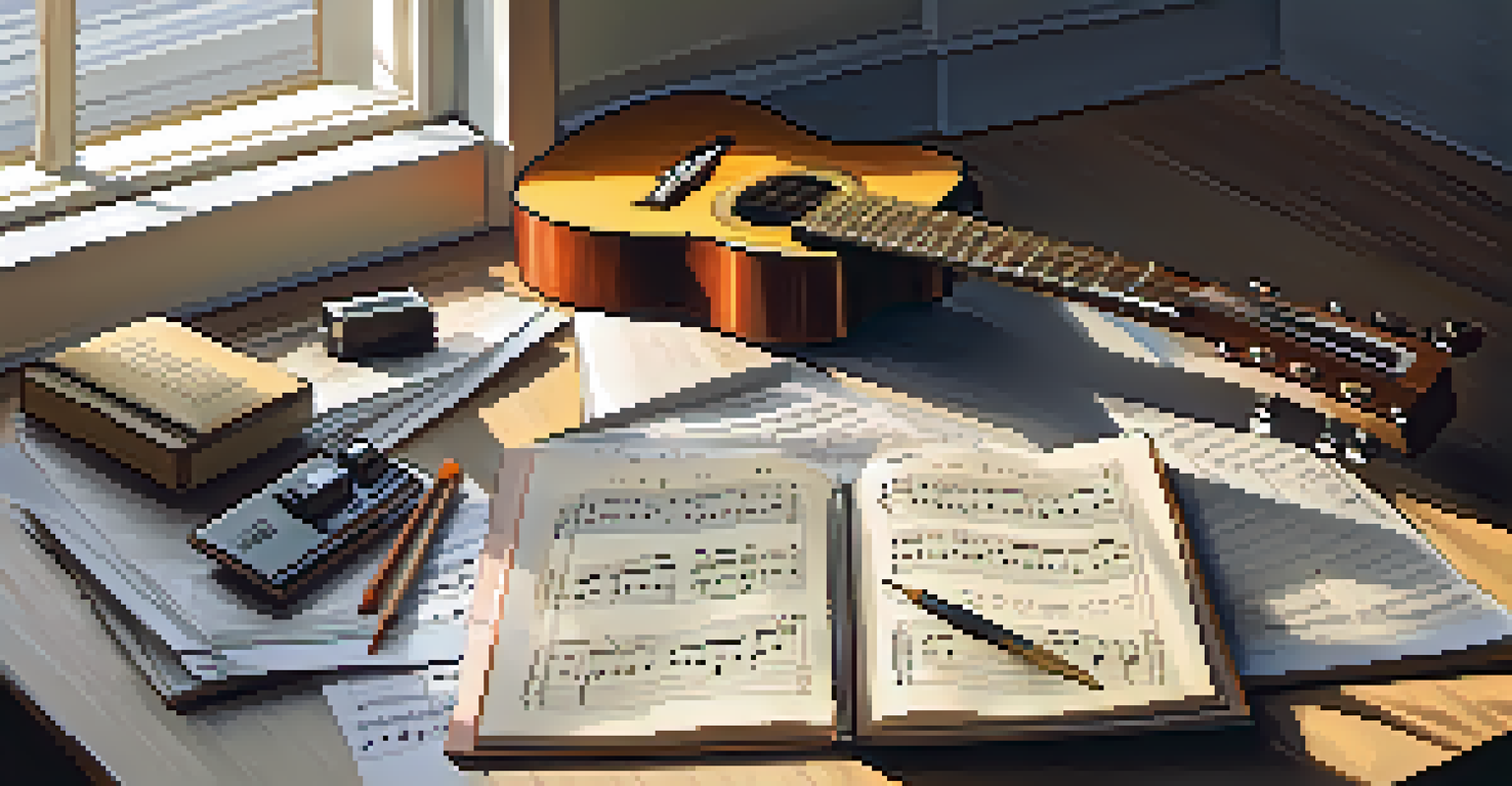Creating Effective Guitar Arrangements for Vocal Songs

Understanding the Role of Guitar in Vocal Arrangements
When arranging guitar for vocal songs, it's essential to recognize the guitar's role. It can either complement the voice or serve as a driving force behind the melody. Think of the guitar as a supportive friend, lifting the vocalist's performance without overshadowing it.
Music is the shorthand of emotion.
A well-placed guitar can emphasize the emotional nuances of the lyrics. For instance, using softer strumming patterns during poignant moments allows the vocalist to shine. This balance creates a rich musical tapestry that engages the listener.
Ultimately, the guitar should enhance the song rather than compete for attention. Achieving this balance requires a keen understanding of both the song's structure and the vocalist's style, ensuring that both elements work harmoniously together.
Choosing the Right Guitar Technique for the Song
Selecting the appropriate guitar technique is crucial for an effective arrangement. Techniques like fingerpicking or strumming can drastically change the song's mood. For example, fingerpicking often brings an intimate feel, ideal for ballads, while energetic strumming works well for upbeat tracks.

Consider the song's genre when deciding on a technique. A bluesy song might benefit from a shuffle strum, while a folk song could shine with gentle fingerpicking. Experimenting with different approaches can help you find the perfect fit.
Guitar Enhances Vocal Performance
The guitar should complement the voice, creating a harmonious balance that enriches the overall arrangement.
Don't be afraid to mix techniques for dynamic contrast. You might start with soft fingerpicking during a verse and transition to strumming in the chorus. This variation keeps the arrangement interesting and highlights the song's emotional peaks.
Harmonizing Guitar Chords with Vocal Melodies
Harmonizing guitar chords with vocal melodies can enhance the overall arrangement. It’s like creating a conversation between the guitar and voice, where both elements support each other. Start by identifying the key of the song and the vocal melody's notes to guide your chord choices.
The guitar is a miniature orchestra in itself.
Using complementary chords can create a fuller sound. For instance, if the vocalist hits a G note, playing a G major chord on the guitar will reinforce that note and add depth to the arrangement. This connection makes the performance more cohesive and engaging.
Experiment with inversions and voicings to add richness. Instead of sticking to basic open chords, try different finger positions to create unique sounds. This subtlety can make a significant difference in how the arrangement feels and resonates with listeners.
Creating Dynamic Arrangements with Variations
Dynamic arrangements can elevate a song from ordinary to extraordinary. Incorporating variations in rhythm, volume, and texture keeps the listener engaged. For example, consider starting softly and gradually building intensity as the song progresses.
Introduce changes at key moments, like the chorus or bridge, to create contrasts. A sudden shift to a stronger strumming pattern can emphasize a lyrical peak, making it more memorable. Think of it as a rollercoaster ride, where the ups and downs keep the audience on the edge of their seats.
Techniques Shape Song's Mood
Choosing the right guitar technique, such as fingerpicking or strumming, can drastically influence the emotional tone of a song.
Another effective approach is varying your guitar parts throughout the song. For instance, you might play a simple chord progression during the verses and add embellishments or solos during instrumental breaks. These variations not only keep the arrangement fresh but also showcase your creativity as a musician.
Incorporating Fingerstyle Techniques for Unique Sounds
Fingerstyle guitar can introduce a unique texture to vocal arrangements. This technique allows for intricate melodies and harmonies that can enhance the song's emotional delivery. Think of it as painting with sound, where each finger's movement adds a new color to the canvas.
Using fingerstyle can often create a more intimate atmosphere, ideal for ballads and soft songs. By plucking individual strings, you can highlight specific notes in the melody, making the arrangement feel more personal. This approach invites the listener into a closer connection with the music.
Don't hesitate to blend fingerstyle with other techniques for added depth. You might strum chords with your thumb while using your fingers to pick out melodies. This combination can create a lush soundscape that captivates your audience and elevates the overall arrangement.
Utilizing Capos for Versatile Guitar Arrangements
A capo can be a game-changer in creating versatile guitar arrangements. By placing a capo on different frets, you can easily change the song's key while maintaining the same chord shapes. This flexibility allows you to adapt the arrangement to suit the vocalist's range.
Using a capo can also introduce new voicings and textures. For instance, placing the capo on the second fret can give a bright sound to a standard chord progression. This can add freshness to a well-known song, making it feel new and exciting.
Practice and Feedback Refine Arrangements
Regular practice and seeking feedback from other musicians are essential for refining your guitar arrangements and enhancing the song's impact.
Experiment with different capo positions to discover unique sounds. A simple shift can transform the mood of a song, opening up new creative possibilities. This small tool can significantly impact your arrangements, making them more engaging for both the performer and the audience.
Finalizing Your Arrangement with Practice and Feedback
Once you've crafted your guitar arrangement, it's time to put it into practice. Rehearsing not only helps solidify your parts but also allows you to identify areas that need adjustment. Think of practice sessions as a workshop where you refine your creation.
Seeking feedback from fellow musicians can offer valuable insights. They may provide fresh perspectives or suggest improvements that you hadn’t considered. Collaboration often leads to discovering new approaches that enhance the arrangement's overall impact.

Remember, the goal is to create an arrangement that serves the song and enhances the vocalist's performance. Be open to making changes, even if it means letting go of ideas you initially loved. Flexibility in your creative process will ultimately lead to a more effective and enjoyable arrangement.